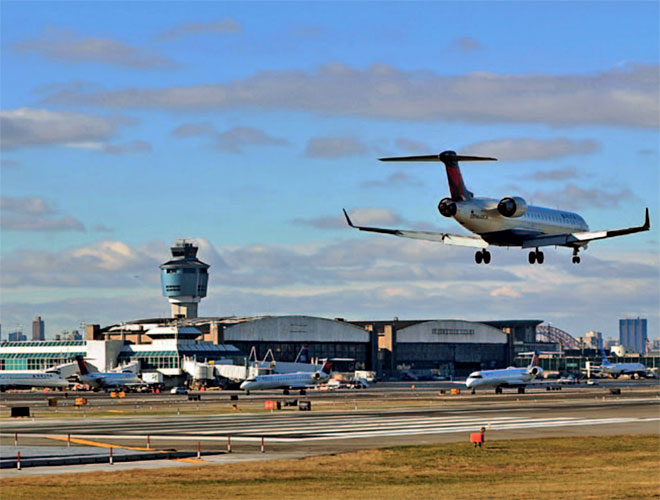
Improvements in a congested region of US airspace will have a positive ripple effect says Teri Bristol, Chief operating officer of the Federal Aviation Administration’s Air Traffic organization.
As Chief Operating Officer of the FAA’s Air Traffic Organization, one of my priorities is to lead the implementation of NextGen into the US National Airspace System.

organization
As part of this effort, we are going to place a new emphasis on deploying NextGen capabilities in the Northeast Corridor (NEC) of the United States.
Spanning the airspace between Boston to Washington DC, the NEC is one of the most heavily congested areas for air traffic in the country.
Half of all US airspace delays originate in this area, with traffic density and adverse weather being major issues.
While the NEC is only a fraction of the total US domestic airspace, it accounts for about 20% of air traffic, including a fair amount from Europe.
In fact, eight of our core 30 airports are in this region, and all of them are in close proximity to each other.
Three of these airports – Newark, LaGuardia and Kennedy – are within 20 miles of each other, and cumulatively handle about 4,000 air traffic operations each day.

forums, we have been able to harness the benefits of open communication,
shared commitment, and sustained collaboration. (Image courtesy of FAA)
Adding to the challenge is the limited ability to build more runways at NEC airports due to a lack of land, along with a heightened concern expressed by local communities about the potential noise impact from changing airspace procedures.
The constrained airspace challenges we face in the NEC are not unlike those in other areas of the world, such as Japan, southeast Asia, and western Europe.
Ripple Effect
The focus in the NEC came about from a need expressed by the US aviation industry.
They prioritized this area for improvements because conditions – and thus improvements – can have a ripple effect on the entire US airspace system.
Our strategy in the NEC is to find ways to improve airport throughput, which, especially during adverse weather, has the biggest impact on reducing delays and cancellations.
Except for extreme situations, we do not generally impose slot controls.
We have asked the US aviation community for specific recommendations, which they have provided through the FAA’s NextGen Advisory committee (NAC).
The NAC includes members from industry and labor, and they are helping us to prioritize, plan and execute our NextGen investments so that we can deliver the greatest amount of benefit in the shortest amount of time.
(Learn More about the benefits of the next generation of air travel. Courtesy of the FAA and YouTube)
For the NEC, we are putting an emphasis on improvements we can make within the next 18-36 months, and will continue to explore capabilities that may take longer.
In October, the NAC submitted a report to the FAA recommending several near-term initiatives that cover improvements in four broad areas: airports, airspace and procedures, tactical initiatives, and tools and technology.
Some of the specific recommendations include:
- Deconflicting arrivals in the New York area
- Improving arrival and departure throughput in New York and Philadelphia areas with time-based flow management tools
- Easing key congestion points that restrict NEC throughput by evolving toward greater use of performance-based navigation procedures, and
- Improving the information available to NEC stakeholders to achieve more common situational awareness and traffic flow management.
To support these efforts, we will examine new concepts to apply simultaneous operations on widely spaced approaches to different airports, and also look at greater use of offshore routes to relieve congestion, an effort that can help with traffic to and from the Caribbean and Africa.
(New satellite arrival procedures into JFK have shaved minutes and miles from flights. See how NextGen helps flights cut the corner into New York. Courtesy of the FAA and YouTube)
Using Leverage
We are in the process of defining the anticipated benefits of the NEC initiative, and developing more specific and robust plans and schedules.
We intend to leverage initiatives that have already begun to improve NEC operations.
Our success with this initiative will depend on several important factors.
- Controllers and pilots will need to safely adopt and adapt to these changes
- Another factor will be the rate at which operators equip with avionics to utilize PBN routing options
- We will also need to engage local communities and address any potential concerns about the impact of noise from changes in airspace
We intend to work closely with our stakeholders to address these issues, among others.
The Northeast Corridor will be one of the first geographical areas where we begin shifting to a time and speed-based air traffic management system.
This will help us realize our longer-term vision of conducting trajectory-based operations, a concept that enables airspace users to strategically manage and optimize trajectories throughout the operation based on the aircraft’s ability to fly precise paths in time and space.
We expect to be able to determine with even greater accuracy where an aircraft intends to be at any point in time along the way to its destination.
Beyond the NEC initiative, we will continue implementing automation tools for time, speed and spacing capabilities in other geographical areas throughout our national airspace system.
Through these efforts, we will be able to make the system more predictable, efficient and flexible, with less disruption from weather, or system or facility outages.
The ATO has made significant progress toward implementing our NextGen modernization effort.
By working closely with the aviation community through the NextGen Advisory committee and other forums, we have been able to harness the benefits of open communication, shared commitment, and sustained collaboration.
(Learn More from “Take off” on NextGen Flight 101 to see firsthand how the FAA has optimized communications, operations, and performance to deliver direct benefits to airlines, airport operations and the flying public. From ground operations to in flight communications, this NextGen Experience will illustrate how the FAA and its partners are changing the way we fly. Courtesy of the FAA and YouTube)
As we proceed with these efforts, we intend to share all the lessons we have learned to support our international work with our CANSO partners.
We will examine new concepts to apply simultaneous operations on widely spaced approaches to different airports, and also look at greater use of offshore routes to relieve congestion, an effort that can help with traffic to and from the Caribbean and Africa
Original post https://www.canso.org/airspace-q4-2017-nextgen-northeast
















